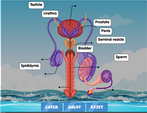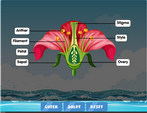Female reproductive system diagram quiz
The female reproductive system is necessary for sexual maturation, sexual function, and urination in females. Like the male reproductive system, it is composed of both internal and external parts.
The external structures are called the genitals or vulva. It contains substances and structures that protect the inner parts from harmful bacteria and particles. The vulva is made of the labia majora, labia minora, clitoris, the Bartholin’s glands, and the opening of the vagina. The urethra, from which urine is expelled, and is also found on the vulva.
The internal organs can be divided into the vaginal or birth canal, the uterus or womb, and the ovaries. The vaginal canal is attached to the uterus via the cervix. Ovaries produce eggs called ova which are fertilized by sperm to produce an embryo – a developing baby.
Every 28 days or so, the ovaries release a mature ovum through the Fallopian tubes to attach onto the uterus. If sperm from ejaculation reaches the uterus at this time, the ovum will be fertilized. If no fertilization occurs, the ovum and the lining of the uterus is shed during menstruation.
With the aid of this female reproductive system diagram quiz, you can better visualize how its different structures work together to enable sexual function in females, as well as birth and pregnancy.











